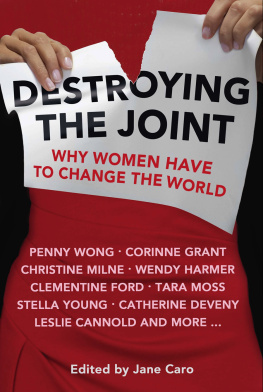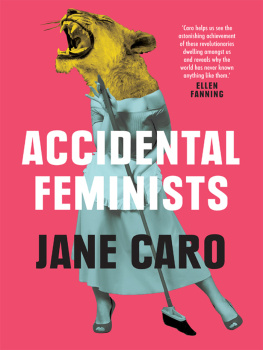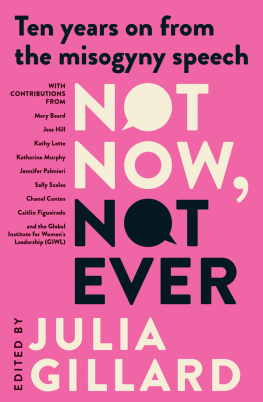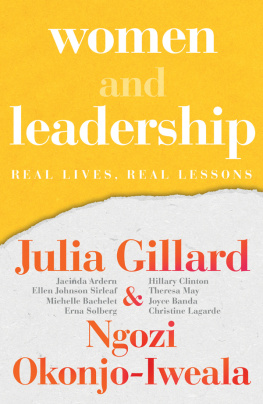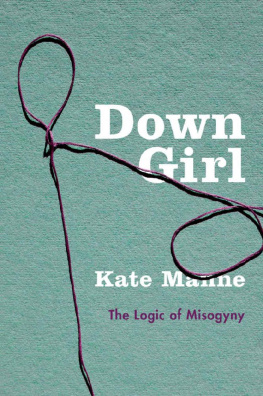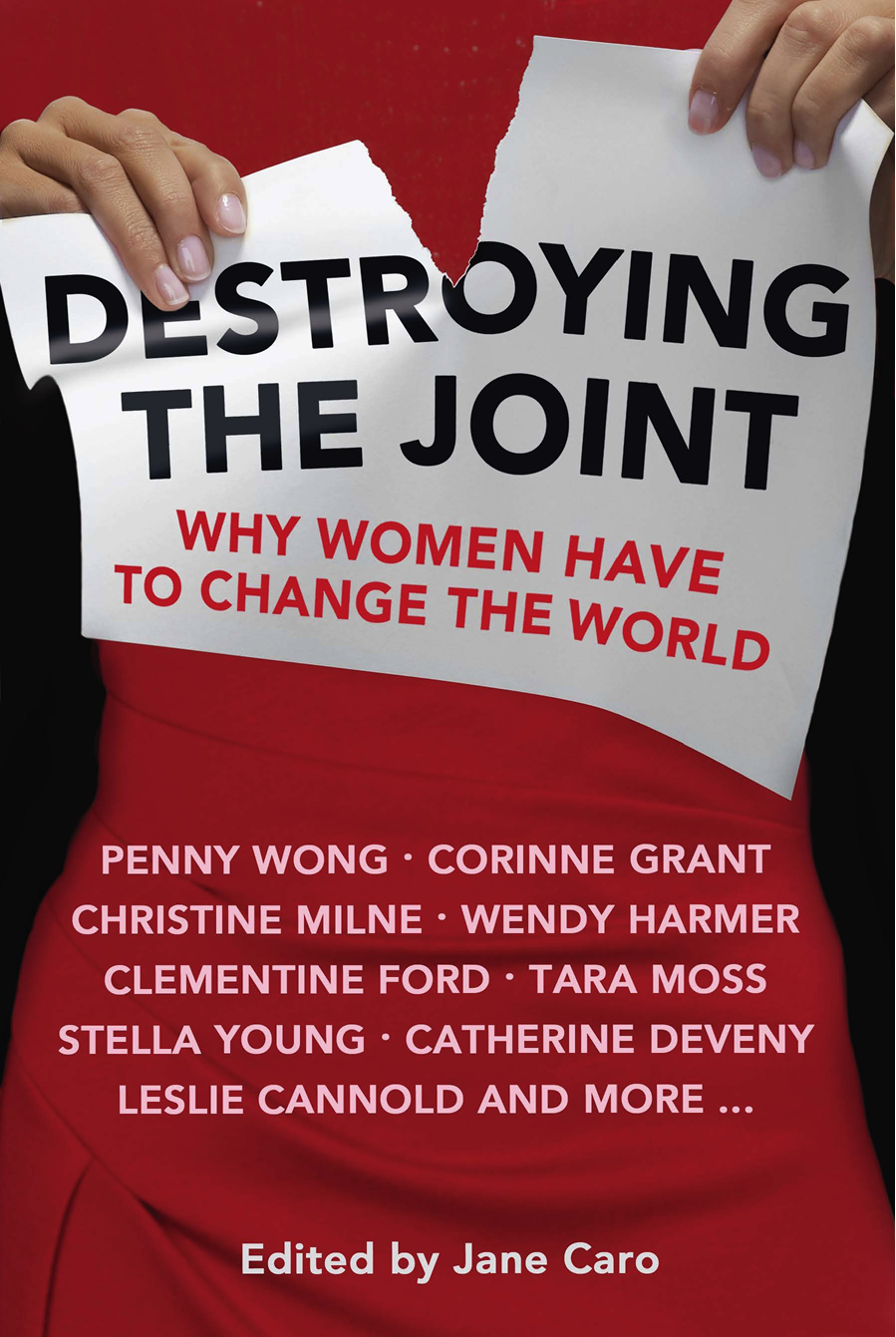
Jane Caro wears many hats, including author, lecturer, mentor, social commentator, columnist, workshop facilitator, speaker, broadcaster and award-winning advertising writer. Jane runs her own communications consultancy and lectures in Advertising Creative at the School of Communication Arts at the University of Western Sydney. She has published four books: The Stupid Country: How Australia Is Dismantling Public Education co-authored with Chris Bonnor (2007), The F Word: How We Learned to Swear by Feminism co-authored with Catherine Fox (2008), Just a Girl (2011) and What Makes a Good School co-authored with Chris Bonnor (2012). She has also appeared on Channel 7s Sunrise , ABCs Q&A and ABCs The Gruen Transfer .
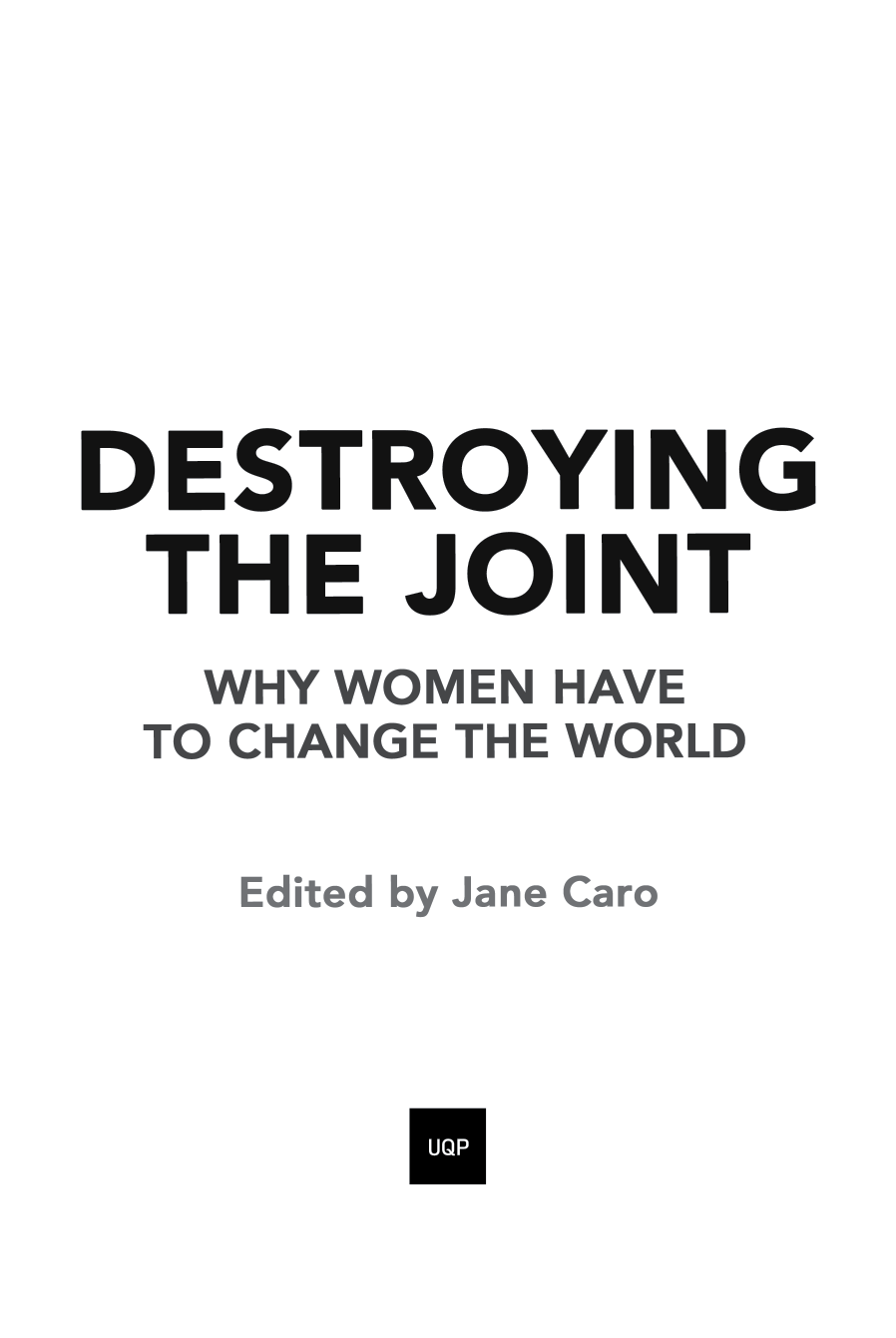
Contents
Jane Caro
Monica Dux
Senator Christine Milne
Michelle Law
Leslie Cannold
Lily Edelstein
Tara Moss
Melissa Lucashenko
Carmen Lawrence
Emily Maguire
Destroy the Joint Administrators
Jennifer Mills
Yvette Vignando
Jenna Price
Catherine Fox
Catherine Deveny
Wendy Harmer
Paula McDonald and Abby Cathcart
Clementine Ford
Corinne Grant
Susan Johnson
Steph Bowe
Dannielle Miller
Nina Funnell
Stella Young
Senator Penny Wong
Krissy Kneen
Introduction: Sometimes You Just Have to Laugh
Jane Caro
On the evening of Friday, 31st of August, 2012, I was sitting around, sipping a glass of wine, keeping one eye on the telly and the other on Twitter. Twitter began to command more of my attention as I saw women responding with understandable hurt and outrage to the comments made by Sydney radio shock jock Alan Jones on his top-rating show that morning. In response to an announcement by Prime Minister Julia Gillard that Australia would donate $300 million to train women in the Pacific region in leadership, Jones declared women leaders were doing enough harm already. He named two Christine Nixon, the ex-Victorian Police Commissioner, and Clover Moore, the current lord mayor of Sydney and said that women leaders were destroying the joint. Jones clearly accepted the all too common view that while the failure of male leaders reflects only on themselves, any mistakes on the part of a female leader whether perceived or actual reflect on the capability of all women to wield power.
As I watched the storm brew, I tweeted the following: Got time on my hands tonight so thought Id come up with new ways to destroy the joint, being a woman and all. Ideas welcome. I hit send with no end in mind except a desire to model how we could respond to Joness remarks without going on the defensive.
What followed was extraordinary, entirely spontaneous and hilarious. Women and men took up the challenge in droves. Jill Tomlinson (clearly more savvy about Twitter than I am) added the now famous hashtag, Jenna Price created a Facebook page, Yvette Vignando whipped up some t-shirts, wristbands and other collateral, and a tweet became a phenomenon. By the end of the first weekend, #destroythejoint was trending worldwide and I was being interviewed by the BBC World Service!
How it developed from there is explained in Jills, Jennas and Yvettes essays later in this book, and by the collective who have turned Destroy the Joint from a cheeky tweet into a powerful and effective agent for change. But we must give Alan Jones his share of the credit. As I described him in a later tweet, he was the gift that just kept on giving. Not content with slagging off women as leaders, he then famously joked a few weeks later that the prime ministers recently deceased father must have died of shame because of her supposed lies. As you will discover as you read this book, thats when Destroy the Joint really showed its muscles.
But why did my original tweet hit such a nerve? Why, at this stage in human history, do women still feel they have to justify their right to be taken seriously?
When Egyptian dictator Hosni Mubarak was ignominiously bundled from power in early 2011, the worlds press went into paroxysms of ecstasy. This was the kind of destroying of joints the West wholeheartedly supported. Headlines around the world declared that people power had sent a tyrant packing. Like most of the rest of the world, I watched the events in Tahrir Square with fascination and excitement, but I am a feminist and that helps me see things differently.
The day after Mubarak fell, many news outlets carried headlines about people power and pictures of the jubilant crowds in Tahrir Square on their front pages. My feminism meant that I automatically scanned those photos for female faces. I found very few. I doubt theyd have made up 1% of those pictured, to be honest.
Just imagine for a moment if the genders of the protesters in Tahrir Square had been reversed; if those pictures had shown 99% women and 1% men. There is no way on earth the headlines would have called it a victory for the people. And thats because, as Jones revealed in his original response to Gillards donation, men can be people but women are still only ever women.
Not that were actually supposed to point that out or complain about it. No, were supposed not only to cop being considered second rate, but collude with those whod rather pretend that it isnt how were thought of at all. This form of mass gaslighting has very effectively kept women more or less in their place for millennia. If you are not familiar with the term gaslighting , it comes from the 1944 film Gaslight , in which Charles Boyer tries to make Ingrid Bergman believe she is losing her mind. Women have adopted the term to describe how they feel when their perceptions and responses to their differential treatment are dismissed or belittled by others, particularly men. Done skillfully enough, it can make women doubt their own senses.
Well, perhaps it is more accurate to say that it used to be able to make us doubt ourselves. Since the advent of social media, the ability of patriarchal societies to isolate and control women by dismissing their perception of the world has been seriously undermined. The reason for this is simple: social media bypasses the old gatekeepers. The people who used to decide who could get access to the public conversation and what they could discuss the vast majority of whom were men are losing their stranglehold. Some are hanging on grimly, of course, as Wendy Harmer points out in her essay on the almost exclusively male world of commercial radio.
But women and other previously marginalised groups now have unmediated access to the public conversation for the first time in history. They are able to post their perceptions of an event, an article, a discussion, a policy, a crime or a stupid remark and instead of being mocked, ridiculed or even just ignored (though they can expect those responses too), they can find common ground with others. As #destroythejoint powerfully demonstrated, the way they see the world is not crazy or illegitimate.
Post Tahrir Square, women began to tell their stories about why they were not demonstrating in greater numbers. Turns out, it was grossly sexualised bullying by what appears to be organised groups of men that kept them away. In India, after a horrendous rape and murder, Dalit women, the most despised people in that country, found the courage to take to the streets in droves to protest. Emily Maguire explores the way marginalised and silenced women are beginning to fight back all over the world in her essay. In Australia, the rape and murder of Jill Meagher followed obsessively on social media as it unfolded brought 30 000 people onto the streets of Melbourne. In Russia, the trial of Pussy Riot was watched and discussed by millions. And social media was quick to point out how comprehensively the mainstream media had missed the point of Julia Gillards now famous sexism and misogyny speech. All over the world, women are mad as hell and refusing to take it any more. Hashtags like #destroythejoint, #everdaysexism and #shoutingback are giving women the courage to speak up and speak out. This is not bullying, it is not fascism, it is not a conspiracy or even very organised. It is spontaneous, real and profoundly democratic. Indeed, we may at last be seeing the emergence of real democracy and freedom of speech.
Next page
